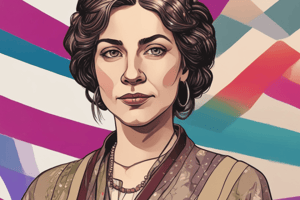Podcast
Questions and Answers
What was the primary focus of the first wave of feminism in the U.S.?
What was the primary focus of the first wave of feminism in the U.S.?
- Employment rights for women
- Economic independence for women
- Women's suffrage (correct)
- Sexual liberation
Which book is credited with influencing the second wave of feminism?
Which book is credited with influencing the second wave of feminism?
- The Feminine Mystique by Betty Friedan (correct)
- The Second Sex by Simone de Beauvoir
- Sexual Politics by Kate Millett
- The Yellow Wallpaper by Charlotte Perkins Gilman
What significant event marked the beginning of the first wave of feminism?
What significant event marked the beginning of the first wave of feminism?
- The ratification of the 19th amendment
- The Seneca Falls Convention (correct)
- The passage of the Equal Rights Amendment
- The publication of The Feminine Mystique
What was the primary disagreement between conservative and radical women's movements during the second wave?
What was the primary disagreement between conservative and radical women's movements during the second wave?
Who were notable women activists mentioned that benefited African-American women during the second wave?
Who were notable women activists mentioned that benefited African-American women during the second wave?
Flashcards are hidden until you start studying
Study Notes
Overview of Women's Rights Movement
- The women's rights movement in the U.S. progressed through several waves from the 19th to the 21st century.
First Wave of Feminism
- Initiated around 1848 with the Seneca Falls Convention focused on women's rights.
- Culminated in 1920 with the ratification of the 19th Amendment, granting women the right to vote.
- After achieving suffrage, the movement became less active for several decades.
Second Wave of Feminism
- Emerged in the 1960s, spurred by the publication of Betty Friedan's "The Feminine Mystique" in 1963.
- Featured a diverse array of women's groups with differing ideologies.
Divisions Among Women's Groups
- Conservative women's movement aimed to uphold the patriarchal system and traditional roles of women.
- Radical women's movement viewed all male-created institutions as oppressive.
- Central debate revolved around the Equal Rights Amendment, proposed by feminists but ultimately not ratified due to opposition from a conservative backlash.
Notable Figures and Contributions
- Activists such as Gloria Steinem and Fanny Lou Hamer played significant roles in supporting young African-American women, especially those in blue-collar jobs.
Studying That Suits You
Use AI to generate personalized quizzes and flashcards to suit your learning preferences.




